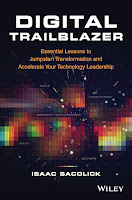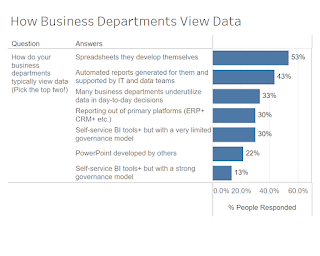It was just over twenty years ago when I was a startup CTO. We spent the late 90s building our platform, customer base, and brand during the internet's growth years. Then in 2000, the dot-com bubble burst. After years of relatively easy funding and a competitive-for-everything environment, we were suddenly conserving cash and looking for efficiencies.
And so I started looking inward, at how our startup was running internally and seeking ways to use tech and data to improve operations.
Finding inefficiencies where there are no apps or SaaS
I didn't have to look hard. Back then, there were relatively few SaaS apps to fill the gaps between core financial and business systems. If it was core to the business, we were probably configuring it in the ERP or the CRM. If it wasn't, it was probably a patched-together workflow involving office docs and emails.
Data processing and reporting were worse. If it wasn't a simple, out-of-the-box report, then chances are someone was wrangling data in spreadsheets and sharing bar charts over PowerPoints. A messy cocktail.
I knew tech could help, but there was no way I was going to reallocate Java developers to build internal workflow applications or reporting. We still had customers to serve and our customer-facing applications to enhance.
Speed and competitiveness did not diminish during the recession that followed the dot-com bubble, but we had to be much more refined about what problems we pursued.
Transforming employee experiences require a low-code tech strategy
So I went looking for cheats - how can I build apps, workflows, databases, and reporting without coding? On a lucky Google search, I discovered Quickbase and POCed an app for our sales team. These were my first steps into the low-code and no-code opportunities that have exploded in today's post-pandemic world.
I tell several other low-code and product development stories in my new book, Digital Trailblazer. There are stories on building customer-facing applications, citizen data science programs, and dataops -all using low-code and no-code technologies.
Using low-code tech to speed up during a recession
Today, we're in the early stages of another recession. Maybe - but it sure feels that way. The CIOs I advise and talk to regularly are planning as if the recession is already here. After the pandemic, supply chain issues, and dramatic shifts in customer expectations, smarter and faster CIOs sense the tea leaves and plan ahead for different business scenarios.
Here's the question, data, and recommendation I shared on LinkedIn this week
Should CIO slow down their digital transformation initiatives?
With 9.1% inflation (WSJ), big tech putting on the hiring freeze (Microsoft, Facebook, Google to name a few), and big drops in startup funding (Q2 funding decreases by 23% QoQ via CBInsights) - CIO will be under pressure to reset their programs.
IMHO, pivot and adjust priorities. Focus efforts. Reset visions and goals. Develop your team and evolve practices. But don't slow down. Speed up in the areas that matter.
While low-code, no-code, citizen development, and citizen data science are used by many CIOs, IT leaders, and Digital Trailblazers, many organizations still have ways to go in making them a pillar of their digital cultures and operating models.
Rolling out low-code requires specialized tech and data leadership skills
I can see some of the challenges from a recent survey I completed during a CIO workshop. When I asked, "How do your business departments typically view data?" and asked respondents to select their top two, their top response was, "Spreadsheets they developed themselves," reported by 53 percent of respondents.
It's a challenge, and in fact, 40 percent of respondents said, "Business leaders just want IT to fix the data" as a top collaboration challenge. When I asked whether CIOs have the tech and data leaders ready to take on roles in citizen data science centers of excellence, the top response reported by 33 percent was that they were lacking these leadership skills.
Attention Digital Trailblazers - and attention to the executives that need Digital Trailblazers to lead transformation initiatives! "Don't slow down. Speed up in the areas that matter!" There's no better time than now to make citizen technologies a transformation force multiplier.
Here's how to start: Find the business workflow gaps that matter and identify leaders that are ready to partner on a rapid implementation. Involve them directly in an agile process to select platforms (if you don't have one already) and iterate on the implementation.
-
Learn more about StarCIO's Center of Excellence programs or contact me with your questions.



No comments:
Post a Comment
Comments on this blog are moderated and we do not accept comments that have links to other websites.